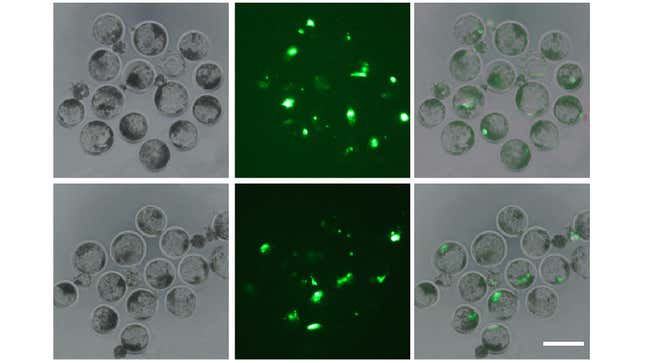
Scientists in China created piglets whose organs contained some monkey cells. The piglets all died within a week, illustrating the challenges ahead as researchers work toward the goal of growing human organs inside other animals.
These pig-monkey chimeras are a scientific first, but to be clear, we’re not talking about some kind of dystopian half-pig, half-monkey. Rather, these animals were mostly pigs, but with a dash of monkey thrown in.
The experiment wasn’t some kind of frivolous Frankensteinian undertaking, either, as the Chinese scientists who led this study are doing some important stage-setting for something bigger: growing human organs inside other animals, pigs in particular. Donated organs are in short supply in China and around the world, so a biotechnology like this would do much to alleviate demand.
Details of this research, which involved scientists from the State Key Laboratory of Stem Cell and Reproductive Biology in Beijing, were published late last month in Protein and Cell.
If this sounds familiar, you may be thinking of similar research done a few years ago. In 2017, researchers from the Salk Institute for Biological Studies in California created human-pig chimeras, but the fetuses were not brought to full term. And relatedly, a collaboration of international scientists created human-monkey embryos earlier this year, sparking considerable controversy.
The new experiment once again involved cells from primates, but this time they were from cynomolgus monkeys. And while the chimeric piglets were brought to full-term during this experiment—a scientific first—it can’t really be called a major breakthrough, because all the piglets died within a week of being born.
To create these chimeras, the scientists grew genetically modified cynomolgus monkey cells in the lab that were capable of expressing GFP—a fluorescent protein that allows scientists to monitor the modified cells and their progeny inside the body of pigs (or any other animal for that matter). Embryonic stem cells were coaxed out from these modified cells and then injected into 5-day-old pig embryos.
The process appears to have been very tedious and frustrating. As New Scientist reports, of the 4,000 chimeric embryos implanted in sows, only 10—a mere 0.25 percent—resulted in piglets.

Tissue and organs were extracted from the specimens and analyzed for the presence of monkey cells. Only two of the 10 piglets were confirmed to be true chimeras, that is, containing biological material (i.e. mitochondrial DNA) from both species. Monkey cells were found in their heart, liver, spleen, lung, brain, and skin, but not in some other organs, such as testes and ovaries. Traces of monkey cells were scant however, ranging from 1 in 1,000 cells to 1 in 10,000 cells.
According to New Scientist, the researchers blamed the IVF procedure, not the experiment itself, for the quick demise of the piglets, as pigs are notoriously difficult to reproduce with IVF. Looking ahead, the researchers would like to refine the procedure and create piglets with organs predominantly composed of primate cells.
In terms of the ethics involved, there is of course the issue of animal experimentation and the prospect of using pigs to harvest human organs. A potentially more contentious issue, however, has to do with the primate cells appearing in the piglets’ brains. Scientists have already expressed concerns about this, particularly the potential for human neural cells to end up inside the brains of chimeric mice. Typically, we prioritize human needs over animal suffering, but what if those animals are technically part-human? It’s a thorny issue that isn’t likely to be resolved any time soon.